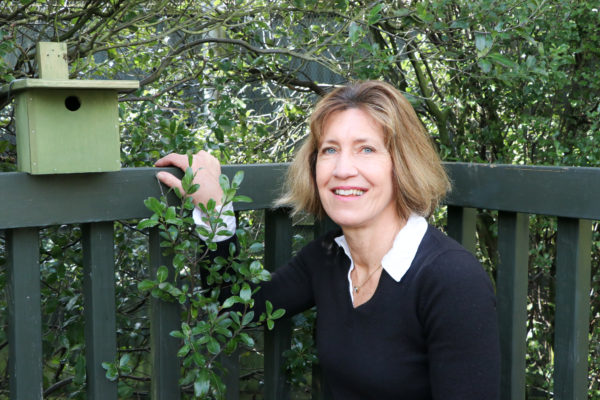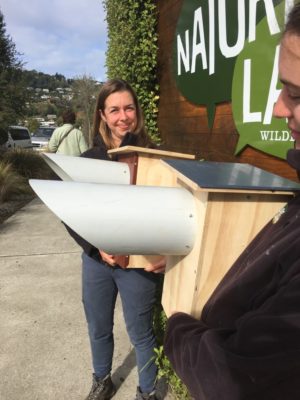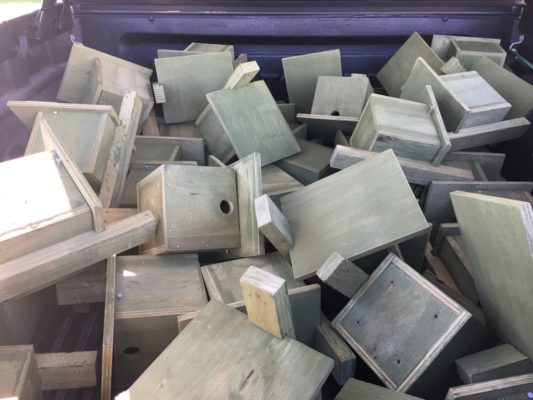Kathryn Marshall, helped by a team of Waimea Menz Shed volunteers, with some expert advice from ornithologist Peter Gaze, has designed and tested predator proof nest boxes for kakariki (parakeets) – and it all came about because she wanted to help another rare bird, the mohua (yellowhead).
But before kakariki, before mohua even – it was cheeky, inquisitive weka that got Kathryn’s attention, which just goes to show how one wildlife encounter can so easily lead to another and another…

Kathryn explains:
“With trapping in the hills around Nelson, western weka came back into properties. It is the first time in my lifetime that weka have been around Nelson city. They were breeding in my garden so I started helping the birds and their chicks, putting out water and food. They would bathe in the water dish and were great parents, raising a number of chicks over a year.
“Mohua had been bird of the year (in 2013) and I thought it would be great to try and bring back mohua to the Nelson region. They used to be locally common and they’re good breeders, but they’ve not been seen in a lifetime. I thought we’ve done it for weka, let’s do it for mohua!”
Kathryn carries out predator control on her own property and is well aware of the threats they pose to a hole-nesting bird like mohua.
“I made a list of the problems:
• predators
• wasps (competitors for honeydew and insects)
• a long time on the nest which is a hole in a tree, making females, eggs and chicks vulnerable
“They’re too long on the nest – but on the positive side they have up to 4 eggs, twice a year and nest in beech forest. Nelson has the right environment, but not the right predator control.”
“Then I talked to people about the best and quickest ways to help mohua, how to control predators and increase their numbers.”

It was Kathryn’s father who suggested predator-proof nests. But what sort of nestbox design would work?
“I talked to (Project Janszoon) ornithologist Peter Gaze who told me about a research paper on riflemen from Canterbury University. It showed that a simple nestbox, where it had a very small 2.5cm hole, most predators couldn’t get it.”
Most, but not all.
There were more questions:
“How do we build it? How to secure it to a tree and secure a lid? What were the best materials cost-wise and for durability? I asked the Menz Shed at Waimea to make one up and we problem-solved with the prototype. We made a variation with a metal plate on front which meant that predators couldn’t get a grip and couldn’t enlarge the small entrance hole.”
“After 3 goes, we came up with 2 prototypes which we showed to Peter Gaze. He thought they were really good! I asked Peter if we could trail them at Brook Waimarama, but it’s a fenced sanctuary without predators, so we trialled them in the ‘halo’ region outside the fence. Peter helped devise a layout and we put 50 up. We worked with Friends of Flora and Project Janszoon to get some trial nest boxes installed this spring. Previous research showed there was a statistically significant increase in riflemen population.”
It was at this point that kakariki came into the picture.
“Natureland in Nelson is breeding kakariki for release and they asked if we’d try and come up with something for them to trial. Rats can even cause problems for the breeders,” Kathryn explains.
Like mohua, wild kakariki usually nest in holes in trees, making adult females and the eggs and chicks very vulnerable. Once again, Menz Shed were keen to help.
“They said ‘we’ll work with you’. Alan Kissell facilitated and Graham Fittock from Menz Shed started looking on ‘Google’ at research. Graham found a pipe design that had been devised for the North American song thrush. The pipe, 15cm diameter was cut on a 49 degrees angle , with cut edges sanded, so that it was too long for predators to enter from the bottom, 18cm, and they couldn’t drop down from the top 36cm. The thrush nested within the tube but kakariki are too big to do that.”
More experimentation followed.
“We took a kakariki nestbox from Natureland and stuck a pipe on the end,” Kathryn says. “Natureland have yellow and red kakariki nest box designs, so we standardised those into one nestbox that we could make. We also needed to look at the core material, because kakariki gnaw nestboxes and we had to provide a safe, chew proof ladder at the bottom for the chicks to fledge.”

“We knew we could keep predators out, but would red and yellow kakariki use the boxes? Would a smaller pipe work with a metal plate?”
The smaller pipe option turned out to be a ‘no’, then a message came through from Natureland. ‘Yes – the kakariki are using the nestboxes’.
In fact when Kathryn and a journalist went along to Natureland to check the results out, they put a nest box up and 3 kakariki immediately started arguing over it. Not only were they using the boxes – they loved them!
The predator-proof nestboxes are currently being used in Natureland’s rat-free breeding areas and are a precaution should rats ever get in. It also means that kakariki are familiar with the boxes and, when birds are subsequently released, nestboxes are put out at the same time for them to use.
The basic pipe design has proven adaptable for all sorts of nestbox variations but Kathryn and her team are yet to test the extent of this usage for additional species of birds.
“Natureland asked for South Island kaka nestboxes,” Kathryn says, “so we refined Zealandia’s North Island kaka nestbox design and the orders were done last week. We’ve had orders for morepork boxes and requests for a South Island saddleback.”
On a personal level, Kathryn is also determined that mohua will soon have their own nestbox design too. It was, after all, why she began this journey.
“It’s all an interim measure before 2050,” explains Kathryn. “We’ve created an option for right now and there has suddenly been heaps of interest. Even though there are predator-proof islands, many of them are short of nest-sites.”
After all, we can’t put all our rare natives on islands. Safer mainland options are very important too, not least in order to maintain genetic diversity.
“MP Nicky Wagner asked if we could roll out the project around all the Menz Sheds in New Zealand,” Kathryn says. “We’re hoping to produce a CAD design that’s easy to share. There’s more to it than you’d think, but we’ve now got a product that works made of materials that are safe.”
What is, perhaps, most amazing of all is that this has all happened in a very short space of time.
“We only started, as a hobby, at the end of last year,” Kathryn says. “Now is the first full breeding season.”

